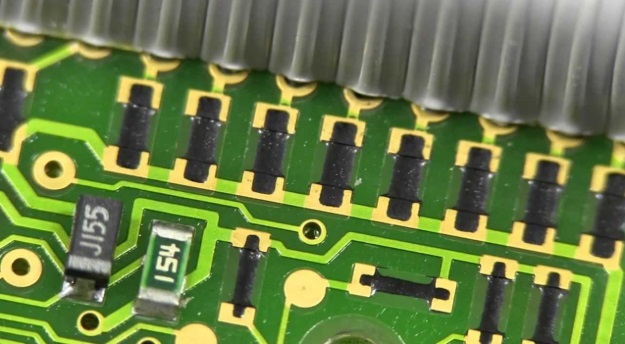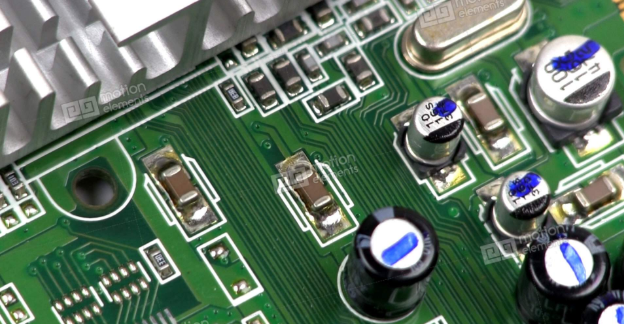Position:Home » Technical Articles
Resistors' Temperature Rise, Heating and Frequency
Writer:Microhm Page View:Date:2019-06-05
Resistor is an element that converts electric energy into heat energy. It always generates heat when the electric power is consumed and the temperature rises according to the consumed power. To control the temperature rise of a resistor, the generated heat needs to be dissipated efficiently.

Some power resistors of Microhm improve the heat radiation by adding heat sink. For chip resistors, the most of the generated heat conducted from the electrode to Cu foil pattern, and finally dissipated to the air or chassis. Temperature rise of the resistor is also controlled by improving thermal conductivity of PWB; by thick Cu foil pattern, forming solid pattern on the back side of PWB or solid pattern inside the layer if it is a multilayer substrate.
Resistors have small parasitic inductance and parasitic capacitance. Thus the higher the frequency becomes, the more the parasitic components are affected, which leads the resistors have reactance components.

We have to pay attention for using resistors in high frequency range because impedance of resistors are affected depending on frequency. The impedance change of resistor depends on resistance. When the resistance is low, parasitic inductance becomes dominant in the high frequency range, which makes higher impedance . When the resistance is high, the parasitic capacitance becomes dominant in high frequency range, which makes smaller impedance. When the resistance is extremely small e.g. under milliohm, surface effect enables to lead the phenomenon that parasitic inductance drops and resistance of resistive body itself increases.

Some power resistors of Microhm improve the heat radiation by adding heat sink. For chip resistors, the most of the generated heat conducted from the electrode to Cu foil pattern, and finally dissipated to the air or chassis. Temperature rise of the resistor is also controlled by improving thermal conductivity of PWB; by thick Cu foil pattern, forming solid pattern on the back side of PWB or solid pattern inside the layer if it is a multilayer substrate.
Resistors have small parasitic inductance and parasitic capacitance. Thus the higher the frequency becomes, the more the parasitic components are affected, which leads the resistors have reactance components.

We have to pay attention for using resistors in high frequency range because impedance of resistors are affected depending on frequency. The impedance change of resistor depends on resistance. When the resistance is low, parasitic inductance becomes dominant in the high frequency range, which makes higher impedance . When the resistance is high, the parasitic capacitance becomes dominant in high frequency range, which makes smaller impedance. When the resistance is extremely small e.g. under milliohm, surface effect enables to lead the phenomenon that parasitic inductance drops and resistance of resistive body itself increases.
Keywords:resistors
Latest News
- Resistor's role in measuring and correcting LED,,,
- Single through-hole resistors' characteristics ,,,
- Why shunt resistors for current sense applicati,,,
- Metal-film resistors with small size, high resi,,,
- 36W High-Current Shunt Resistors MMS8420,,,
- 1W Surface Mount Resistor MPR1206,,,
- An Overview of Microhm Electronics' Resistor Pr,,,
- More anti-sulfur resistors used in harsh envir,,,
- Resistance changes with temperature,,,
- 140W TO247 High Power Heatsinkable Resistor,,,
- MMS5930 is ideal for current sensing in industr,,,
- Shunt resistors selection for engineers' design,,,
- Considerations for choosing precision resistors,,,
- Ceramic Encased Cement Resistors NWH Series for,,,
- Resistors for Passive Balancing in Battery-Pow,,,
Hot Articles
- Microhm will take part in 10th Automotive World,,,
- Thanks for Visiting Microhm's Booth E5-5706 in ,,,
- Resistors in Short Supply: Blame Cars,,,
- New lunch: High Power Precision Shunt Resistor,,,,
- How to Test a Resistor,,,
- Innovative Technology, Future Electric: Electri,,,
- What is Precision Resistors?,,,
- SMD Resistors Sizes and Packages,,,
- The Construction and Features of Metal Film Res,,,
- What is a TO-220 Resisor?,,,
- Hot Selling Products: Precision Shunt Resistors,,,
- How to Calculate the Equivalent Resistance Valu,,,
- What is a Fixed Resistor?,,,
- Resistors in LED Circuits,,,
- Resistors Types and Materials Overview,,,
Resistance applications
- Why Zero-Ohm Resistors?,,,
- Heater Blower Motor Resistor in Air Conditioner,,,
- The Four Important Functions of Alloy Resistors,,,
- Select the Right Resistor for Harmonic Filterin,,,
- Industrial Roberts Applied to Solar Photovoltai,,,
- Difference Between High Precision Resistors and,,,
- Urbanization Development Bringing the Transform,,,
- Carbon Film Resistors' Features and Application,,,
- Miniature future for passive electronic compone,,,
- Surface Mount Resistor's Size and Package ,,,
- Shunt Resistor MMS8420 for High Current Stable ,,,
- BMS for New Energy Vehicle,,,
- Precision Resistors' Construction and TCR,,,
- The Main Application for High Precision and Low,,,
- The Measurement Accuracy of Automotive Shunt is,,,
